Artist’s rendition of the LGM-35A Sentinel intercontinental ballistic missile. (Image: Northrop Grumman)
RIAT 2024 — As the Air Force considers how to restructure the procurement of its massively over-budget nuclear ICBM replacement, one option on the table could involve stripping away portions of Northrop Grumman’s current contract and opening them back up for wider competition, the service’s top acquisition official said today.
Earlier this month, the Pentagon determined that it would continue the LGM-35A Sentinel program despite an 81 percent increase in cost, mostly driven by problems associated with revamping ground-based infrastructure like missile silos.
But just because the Pentagon made the decision not to terminate the program doesn’t mean it will continue in its current incarnation, Andrew Hunter told reporters here today. The Air Force is required by law to formulate a new acquisition strategy that could contain an alternate approach for developing Sentinel’s infrastructure.
“Both Secretary Kendall and I are big fans of competition. So we’re going to take a look at the right approach to getting after, particularly, the ground piece going forward,” Hunter said. “I think there are elements of the ground infrastructure where there may be opportunities for competition that we can add to the acquisition strategy for Sentinel.”
That potential scenario could shake up the program for prime contractor Northrop Grumman, which was awarded a $13.3 billion contract in 2020 after Lockheed Martin was eliminated from the competition and Boeing — the lone remaining company vying for the program — dropped out. (A Northrop official previously told reporters that the company’s “main construction partner” is Bechtel, and that Clark Construction is serving an advisory role.)
Northrop referred back to a previous statement on the program, which states that, “‘DoD’s certification and funding validates continued confidence in the Sentinel weapon system and its critical role in safeguarding global security. In partnership with the Air Force, Northrop Grumman is making important progress on this highly complex weapon system.”
While Hunter stressed that no final decisions on how to restructure the program have been made, he said the Air Force may be able to facilitate competition by breaking up the infrastructure portion of the contract into “smaller bites,” allowing a wider number of companies to bid only on projects where they could drive a reduction in price.
“To get more competition, you’re going to look at not just taking a giant chunk of the program out but just the tasks that are more easily computed,” he said, adding that, “it’s something to look at.”
The Defense Department most recently estimated that total costs for Sentinel could reach as high as $141 billion unless major steps are taken to drive down the price. Despite the spiraling costs, the department opted to continue on with the program because “no alternatives” were equally viable and less costly, Pentagon acquisition czar Bill LaPlante said earlier this month.
In the wake of its Nunn McCurdy breach — the congressionally-mandated cost threshold that forces the Pentagon to review whether a program should continue — the department rescinded the program’s Milestone B declaration while the Air Force figures out how to revamp its acquisition strategy.
The timeline for reinstating the Milestone B declaration could take about 18 to 24 months, Hunter said.
“The acquisition strategy we will have to have early in that process, because it’s fundamental to the entire approach. You need to know what the acquisition strategy is,” he said. “So we’ll work the acquisition strategy on the front end, but to get to a final new plan will take some time.”
Despite the difficulties on the ground-based portion of the contract, work on the actual missile system by Northrop Grumman is proceeding well, Lt. Gen Andrew Gebara, deputy chief of staff for strategic deterrence and nuclear integration, said earlier this month.
“It is important to remember [for] the program that stage one, two and three of the missile have been successfully test fired already. I’m not going to say that retired every risk on the missile. But largely the issues of the missile are known issues that can be worked, and are largely okay,” he said.











